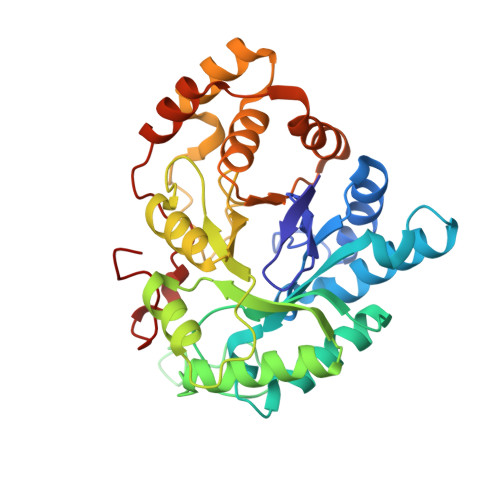Mouse 17alpha-Hydroxysteroid Dehydrogenase (AKR1C21) Binds Steroids Differently from other Aldo-keto Reductases: Identification and Characterization of Amino Acid Residues Critical for Substrate Binding.
Faucher, F., Cantin, L., Pereira de Jesus-Tran, K., Lemieux, M., Luu-The, V., Labrie, F., Breton, R.(2007) J Mol Biol 369: 525-540
- PubMed: 17442338
- DOI: https://doi.org/10.1016/j.jmb.2007.03.058
- Primary Citation of Related Structures:
2IPF, 2IPG, 2IPJ - PubMed Abstract:
The mouse 17alpha-hydroxysteroid dehydrogenase (m17alpha-HSD) is the unique known member of the aldo-keto reductase (AKR) superfamily able to catalyze efficiently and in a stereospecific manner the conversion of androstenedione (Delta4) into epi-testosterone (epi-T), the 17alpha-epimer of testosterone. Structural and mutagenic studies had already identified one of the residues delineating the steroid-binding cavity, A24, as the major molecular determinant for the stereospecificity of m17alpha-HSD. We report here a ternary complex crystal structure (m17alpha-HSD:NADP(+):epi-T) determined at 1.85 A resolution that confirms this and reveals a unique steroid-binding mode for an AKR enzyme. Indeed, in addition to the interactions found in all other AKRs (van der Waals contacts stabilizing the core of the steroid and the hydrogen bonds established at the catalytic site by the Y55 and H117 residues with the oxygen atom of the ketone group to be reduced), m17alpha-HSD establishes with the other extremity of the steroid nucleus an additional interaction involving K31. By combining direct mutagenesis and kinetic studies, we found that the elimination of this hydrogen bond did not affect the affinity of the enzyme for its steroid substrate but led to a slight but significant increase of its catalytic efficiency (k(cat)/K(m)), suggesting a role for K31 in the release of the steroidal product at the end of the reaction. This previously unobserved steroid-binding mode for an AKR is similar to that adopted by other steroid-binding proteins, the hydroxysteroid dehydrogenases of the short-chain dehydrogenases/reductases (SDR) family and the steroid hormone nuclear receptors. Mutagenesis and structural studies made on the human type 3 3alpha-HSD, a closely related enzyme that shares 73% amino acids identity with the m17alpha-HSD, also revealed that the residue at position 24 of these two enzymes directly affects the binding and/or the release of NADPH, in addition to its role in their 17alpha/17beta stereospecificity.
Organizational Affiliation:
Oncology and Molecular Endocrinology Research Center, Laval University Medical Center (CHUL), Laval University, Québec, Canada G1V 4G2.



















